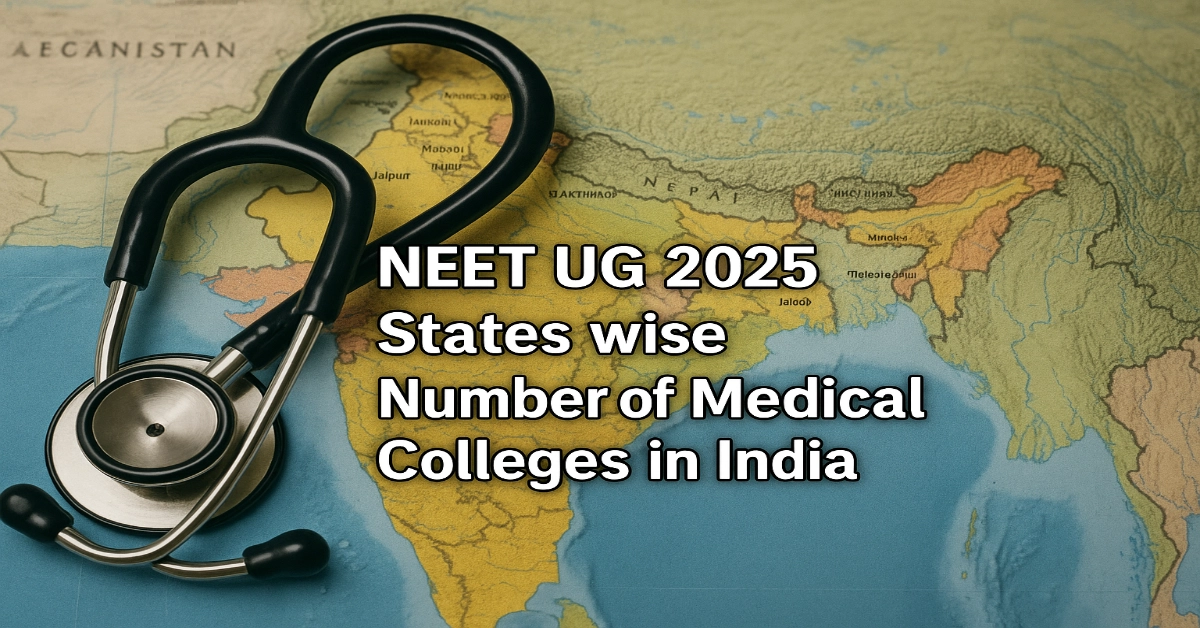New Delhi: India continues to strengthen its medical education infrastructure with a total of 706 medical colleges offering 1,18,709 medical seats across the country. As per the latest NMC data, out of these 706 medical colleges in India, 386 are government colleges, while 320 are private medical colleges. This shows a balanced growth in both public and private sectors in the field of medical education.
Top States with the Highest Number of Medical Colleges
Some states have emerged as leading hubs for medical education. Here’s a look at the top contributors:
- Uttar Pradesh: 86 medical colleges
- Maharashtra: 80 medical colleges
- Tamil Nadu: 77 medical colleges
- Karnataka: 73 medical colleges
- Telangana: 65 medical colleges
- Rajasthan: 43 medical colleges
- Gujarat: 41 medical colleges
- Andhra Pradesh: 38 medical colleges
- West Bengal: 38 medical colleges
- Kerala: 34 medical colleges
Total Government Medical Colleges in India 2025
Based on the latest data from the National Medical Commission (NMC), India has a total of 386 government medical colleges offering MBBS programs. These institutions are distributed across various states and union territories, contributing significantly to the nation’s healthcare education infrastructure. Here is a table presenting state-wise numbers of government medical colleges in India:
| State/UT | Number of Government Medical Colleges |
|---|---|
| Uttar Pradesh | 35 |
| Maharashtra | 25 |
| Tamil Nadu | 38 |
| Karnataka | 21 |
| Telangana | 17 |
| Rajasthan | 17 |
| Gujarat | 18 |
| Andhra Pradesh | 13 |
| West Bengal | 20 |
| Kerala | 10 |
| Madhya Pradesh | 14 |
| Bihar | 12 |
| Odisha | 9 |
| Punjab | 3 |
| Haryana | 5 |
| Chhattisgarh | 10 |
| Assam | 9 |
| Jharkhand | 6 |
| Himachal Pradesh | 7 |
| Uttarakhand | 4 |
| Jammu and Kashmir | 9 |
| Tripura | 1 |
| Manipur | 2 |
| Meghalaya | 1 |
| Nagaland | 1 |
| Sikkim | 0 |
| Arunachal Pradesh | 1 |
| Mizoram | 1 |
| Goa | 1 |
| Chandigarh | 1 |
| Delhi | 8 |
| Puducherry | 2 |
| Andaman and Nicobar Islands | 1 |
| Dadra and Nagar Haveli & Daman and Diu | 1 |
| Lakshadweep | 0 |
| Total | 386 |
This distribution highlights the government’s efforts to enhance medical education accessibility across the country. States like Tamil Nadu and Uttar Pradesh have a higher number of government medical colleges, reflecting their commitment to expanding public healthcare education.
Total Private Medical College in India 2025
As per the latest NMC data, India has 320 private medical colleges offering approximately 53,256 MBBS seats. These institutions follow the same syllabus and exam pattern as government medical colleges, ensuring a uniform standard of medical education across the country. Here is a table presenting state-wise numbers of private medical colleges in India:
| State/UT | Number of Private Medical Colleges |
|---|---|
| Karnataka | 49 |
| Maharashtra | 37 |
| Uttar Pradesh | 36 |
| Tamil Nadu | 31 |
| Telangana | 27 |
| Andhra Pradesh | 22 |
| Kerala | 25 |
| Gujarat | 15 |
| Rajasthan | 9 |
| Punjab | 7 |
| Madhya Pradesh | 11 |
| Haryana | 8 |
| West Bengal | 7 |
| Odisha | 5 |
| Chhattisgarh | 4 |
| Uttarakhand | 3 |
| Bihar | 3 |
| Jharkhand | 2 |
| Himachal Pradesh | 1 |
| Tripura | 1 |
| Sikkim | 1 |
| Puducherry | 7 |
| Others (NE & UTs) | 6 |
| Total | 320 |
Government vs Private: State-Wise Variations
While the total numbers are impressive, the ratio of government to private medical colleges varies significantly between states. For instance:
- Karnataka has a higher share of private medical colleges, making it an attractive destination for students seeking admission through management or NRI quotas.
- In contrast, Tamil Nadu has established a strong network of government medical colleges, helping it offer more affordable education options to students from different backgrounds.
Growing Opportunity for Medical Aspirants
This expansion in the number of medical colleges reflects the government’s continued focus on improving access to medical education and healthcare services. It also opens up more opportunities for NEET aspirants and others looking to pursue careers in the medical field.
As India works to bridge the gap in the doctor-patient ratio and improve rural healthcare, the rise in medical institutions will play a crucial role in producing qualified professionals across all regions of the country.

